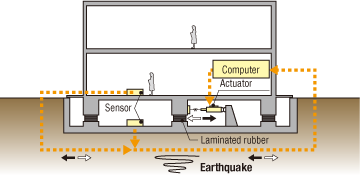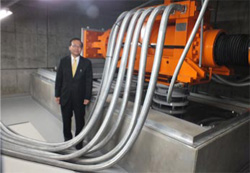Home > Highlighting JAPAN > Highlighting Japan DECEMBER 2011 > A Whole Lot Less Shaking Going On
Highlighting JAPAN
COVER STORY: Pillars of Strength
A Whole Lot Less Shaking Going On
Obayashi Corporation, one of Japan's leading construction groups, has developed the world's first super-active seismic base isolation system. Called Laputa 2D, it reduces building shaking to 1/50 of actual ground shaking. Toshio Matsubara reports.

Concept of Laputa 2D
Credit: COURTESY OF OBAYASHI CORPORATION
In 2009, the leading construction group Obayashi Corporation was the first in the world to develop a method that improved on the existing technique, namely Laputa 2D.
The basic principle of this system is to immediately move buildings the same distance that the buildings were moved by earthquakes, in the opposite direction. If the ground moves to the right by 10 cm, the building is immediately moved to the left by 10 cm. As a result, the shaking is counteracted, and the building stops moving. In buildings that incorporate conventional seismic isolation devices, shaking is estimated at between 1/2 and 1/5 of the actual ground shaking, whereas in buildings where Laputa 2D is installed, shaking is substantially reduced to between 1/30 and 1/50 of the actual ground shaking.
The basis of Laputa 2D is the action of a device called an actuator, which uses oil pressure to push and pull the laminated rubber bearings that support the building in accordance with instructions from a newly developed high-performance computer. When an earthquake occurs, a sensor detects the shake of the ground and the shake of the building and immediately transmits the size and direction of the shake to a computer. The computer calculates in real time the distance the ground has moved, and issues an instruction to the actuator in units of 1/1000 second. 0.1 seconds after the shaking has occurred, the actuator operates to move the framework of the building in the opposite direction of the shaking.
Hideo Katsumata, deputy general manager of Obayashi Corporation's Technical Research Institute, who led the development of Laputa 2D, says, "We were already thinking about the idea that led to the current Laputa 2D in 1988. But at that time, computers were not powerful enough. The key factors that enabled us to make Laputa 2D a reality were great advances in computing speed and accuracy and the fact that it became possible to keep actuator manufacturing costs low. The increase of social needs requiring further seismic isolation also supported realization of Laputa 2D."

Hideo Katsumata of Obayashi Corporation alongside a Laputa 2D actuator. Oil flows through the pipes in front of him to move the actuator.
Credit: TOSHIO MATSUBARA
Obayashi Corporation's Technical Research Institute is the first building in the world to use the technology, with a total of four actuators and sixteen laminated rubber bearings. Since any increase in the weight of a building can be addressed by adding actuators and laminated rubber bearings, this system can basically be introduced into buildings of any size.
The Great East Japan Earthquake that occurred on March 11 provided the company with an assurance of the safety of this system, as well as showing the company the areas for improvement. Since the earthquake caused the Technical Research Center to shake more violently than the size initially set, the safety mechanism kicked in and stopped the actuators from operating. During the course of that day the maximum set point for shaking changed, and as a result, the actuators operated immediately for all the aftershocks that followed. The shaking experienced at that time was a very slight movement in a vertical direction only, with no horizontal shaking.
"One of the aims of developing Laputa 2D was to stop the numerous wheeled devices and appliances in hospitals from moving in an earthquake. Existing seismic isolation buildings cannot possibly fulfill this requirement," says Katsumata. There are a large number of facilities that have a need for Laputa 2D, including hospitals, art galleries, and museums, as well as manufacturing premises for precision measuring equipment. The challenge now is to come up with initiatives for further cost reduction so that it can be widely used.
"Currently too, partial seismic isolation is being implemented. This involves the creation of a new floor with a built-in seismic isolation system, not in the building as a whole but only in the part of the building where shaking needs to be reduced, thereby minimizing costs," says Katsumata.
© 2009 Cabinet Office, Government of Japan






